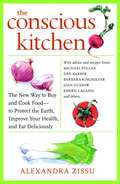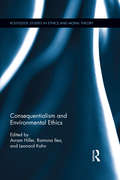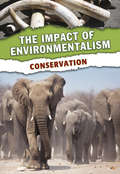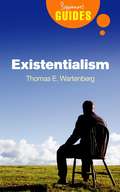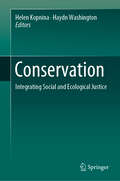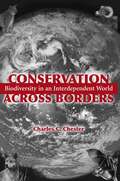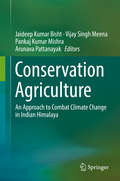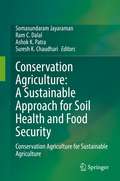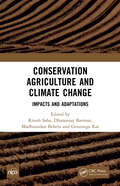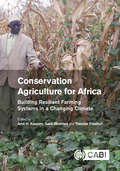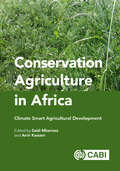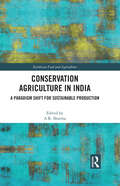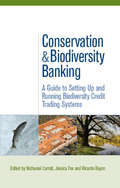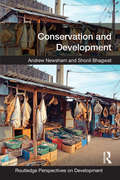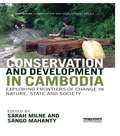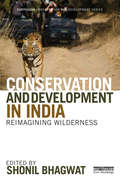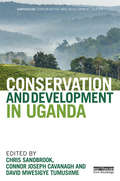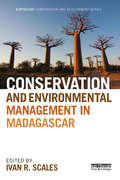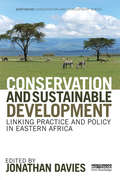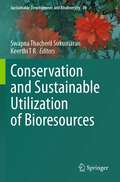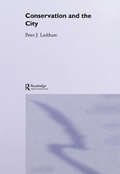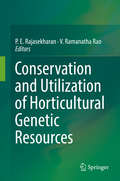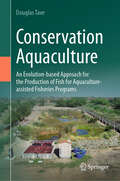- Table View
- List View
Conscious Business in Germany: Assessing the Current Situation and Creating an Outlook for a New Paradigm (CSR, Sustainability, Ethics & Governance)
by Nicolas Josef Stahlhofer Christian Schmidkonz Patricia KraftThis book presents conscious business as a constantly expanding and powerful approach to reinvent and shape organizations in a human and beneficial manner. In particular it examines the core characteristics, main drivers and challenges of conscious businesses in Germany. The book offers a structured overview of the current situation of the concept and outlines important issues that need to be considered in order to make independent decisions. Four case studies of successful conscious companies - differing in terms of their size, industry, legal form and international orientation - reveal concrete best practices and provide evidence for the approach's ability to deliver business paradigms that are simultaneously purposeful and profitable.
The Conscious Kitchen: The New Way to Buy and Cook Food - to Protect the Earth, Improve Your Health, and Eat Deliciously
by Alexandra ZissuYour everyday food choices can change the world--and make meals taste better than ever For anyone who has read The Omnivore's Dilemma or seen Food, Inc. and longs to effect easy green changes when it comes to the food they buy, cook, and eat, The Conscious Kitchen is an invaluable resource filled with real world, practical solutions. Alexandra Zissu walks readers through every kitchen-related decision with three criteria in mind: what's good for personal health, what's good for the planet, and what tastes great. Learn, among other things, how to: - Keep pesticides, chemicals, and other harmful ingredients out of your diet- Choose when to spend your dollars on organic fruit and when to buy conventionally grown- Avoid plastic--including which kinds in particular and why- Figure out what seafood is safe to eat and is sustainable- Use COOL (country of origin labels) to your advantage- Determine if a vegetable is genetically modified just from reading its PLU (price look up) code- Decipher meat labels in the supermarket- Cook using the least energy--good for the earth and your wallet- Eat locally, even in winter - Understand what "natural" and other marketing terms really mean- Buy packaged foods wisely Navigate farmers' markets, giant supermarkets, and every shop in between to find the freshest and healthiest local ecologically grown and produced meat, dairy, fruits, and vegetables--no matter where you live With The Conscious Kitchen as your guide, you will never again stand in the market bewildered, wondering what to buy. You can feel confident you are making the best possible choices for you, your family, and our planet. ALEXANDRA ZISSU writes about green living, food, and parenthood. She is the author of The Conscious Kitchen, coauthor of The Complete Organic Pregnancy, and contributes the "Ask an Organic Mom" column to The DailyGreen.com. Her stories have appeared in The New York Times, The Green Guide, Cookie, Details, Bon Appétit, Self, and Health, among other publications. She is also a public speaker and "greenproofer," an eco-lifestyle consultant. Visit her website, www.alexandrazissu.com.
Consequentialism and Environmental Ethics: Consequentialism And Environmental Ethics (Routledge Studies in Ethics and Moral Theory)
by Ramona Ilea Avram Hiller Leonard KahnThis volume works to connect issues in environmental ethics with the best work in contemporary normative theory. Environmental issues challenge contemporary ethical theorists to account for topics that traditional ethical theories do not address to any significant extent. This book articulates and evaluates consequentialist responses to that challenge. Contributors provide a thorough and well-rounded analysis of the benefits and limitations of the consequentialist perspective in addressing environmental issues. In particular, the contributors use consequentialist theory to address central questions in environmental ethics, such as questions about what kinds of things have value; about decision-making in light of the long-term, intergenerational nature of environmental issues; and about the role that a state’s being natural should play in ethical deliberation.
Conservation
by Susan M. Canney Clive HamblerThe importance of conservation is growing each year, with increasing concerns over the destruction of biodiversity and the rising awareness of ecosystem services generating new debates on the human-nature relationship. This compact overview integrates the process, theory and practice of conservation for a broad readership, from non-specialists to students and practitioners. Taking a global perspective, it uses examples from around the world to illustrate general themes and show how problems arise from the impact of societal trends on ecological communities. A significant practical component will be particularly valuable for environmental professionals, outlining the requirements for rigorous surveys, biodiversity valuation, the assessment of impact and its mitigation. Thoroughly revised and updated, this second edition reflects trends towards embracing multiple disciplines, considering the links between ecology and the social sciences and bringing conservation to the heart of sustainability and environmental policy.
Conservation (The Impact of Environmentalism)
by Jen GreenWe are all aware of the importance of the environment - it's in the news, it affects our behavior and the decisions we make every day. But what actual impact has environmental thinking had on the world around us? This thought-provoking book looks at the way changing ideas about the environment and sustainability have affected our attitudes to conservation, and will do so in the future.
Conservation: A Beginner's Guide (Beginner's Guides)
by Paul Jepson Richard LadleThe need to protect nature has never been so pressing. As unprecedented environmental challenges threaten to wipe out many of the planet's species, there is a battle against time to formulate new ways of defending nature. Jepson and Ladle cover all aspects of modern conservation from inspiring successes to the most urgent crises, introduce exciting new techniques such as re-wilding and adaptive management, and explain how we can all contribute. Essential reading for anyone who does not want to see the last of pandas, polar bears, and parrots. Dr. Paul Jepson and Dr. Richard Ladle both work at the University of Oxford.
Conservation: Integrating Social and Ecological Justice (Routledge Explorations In Environmental Studies)
by Helen Kopnina Haydn WashingtonThis book provides keys to decrypt current political debates on the environment in light of the theories that support them, and provides tools to better understand and manage environmental conflicts and promote environmentally friendly behaviour. As we work towards global sustainability at a time when efforts to conserve biodiversity and combat climate change correspond with land grabs by large corporations, food insecurity, and human displacement. While we seek to reconcile more-than-human relations and responsibilities in the Anthropocene, we also struggle to accommodate social justice and the increasingly global desire for economic development. These and other challenges fundamentally alter the way social scientists relate to communities and the environment. This book takes as its point of departure today’s pressing environmental challenges, particularly the loss of biodiversity, and the role of communities in protected areas conservation. In its chapters, the authors discuss areas of tension between local livelihoods and international conservation efforts, between local communities and wildlife, and finally between traditional ways of living and ‘modernity’. The central premise of this book is while these tensions cannot be easily resolved they can be better understood by considering both social and ecological effects, in equal measure. While environmental problems cannot be seen as purely ecological because they always involve people, who bring to the environmental table their different assumptions about nature and culture, so are social problems connected to environmental constraints. While nonhumans cannot verbally bring anything to this negotiating table, aside from vast material benefits that society relies on, the distinct perspective of this book is that there is a need to consider the role of nonhumans as equally important stakeholders – albeit without a voice. This book develops an argument that human-environmental relationships are set within ecological reality and ecological ethics and rather than being mutually constitutive processes, humans have obligate dependence on nature, not vice versa. This would enable an ethical position encompassing the needs of other species and giving simultaneous (without one being subordinated to another) consideration to justice for humans and non-humans alike. The book is accessible to both social scientists and conservation specialists, and intends to contribute to strengthening interdisciplinary collaborations in the field of conservation.
Conservation Across Borders: Biodiversity in an Interdependent World
by Charles C. ChesterConservationists have long been aware that politicalboundaries rarely coincide with natural boundaries.From the establishment of early "peace parks"to thedesignation of continental migratory pathways, awide range of transborder mechanisms to protectbiodiversity have been established by conservationistsin both the public and private sectors.Conservation Across Borders presents a broadoverview of the history of transboundary conservationefforts and an accessible introduction to current issues surroundingthe subject. Through detailed examinations of two initiatives, theInternational Sonoran Desert Alliance (ISDA) and the Yellowstone toYukon Initiative (Y2Y), the book helps readers understand the benefitsand challenges of landscape-scale protection.In addition to discussing general concepts and the specific experienceof ISDA and Y2Y, the author considers the emerging concept of "conservationeffectiveness" and offers a comparative analysis of the twoprojects. The book ends with a discussion of the complex relationshipsamong civil society, governments, and international borders.By considering the history, goals, successes, and failures of two divergentinitiatives, the book offers important insights into the field oftransborder conservation along with valuable lessons for those studyingor working in the field.
Conservation Agriculture: An Approach to Combat Climate Change in Indian Himalaya
by Jaideep Kumar Bisht Vijay Singh Meena Pankaj Kumar Mishra Arunava PattanayakThis book showcases a compilation of case studies presented by scientists, teachers and academics and covers contemporary technologies for combating climate change, including sustainable agricultural management practices and conservation agriculture. It highlights the situations that future generations in the Indian Himalayas will face, and addresses the major challenges for tomorrow's generations in their efforts to ensure sufficient food production for the global population. It also sheds light on the factors that are routinely ignored in connection with agricultural management practices for sustainable food production and risk assessment. Lastly, it illustrates the need to develop a comprehensive master plan for strategic planning, including conservation agriculture practices that address poverty and food security in the wake of climate change impacts.
Conservation Agriculture: Conservation Agriculture for Sustainable Agriculture
by Somasundaram Jayaraman Ram C. Dalal Ashok K. Patra Suresh K. ChaudhariFeeding the increasing global population, which is projected to reach ~10 billion by 2050, there has been increasing demands for more improved/sustainable agricultural management practices that can be followed by farmers to improve productivity without jeopardizing the environment and ecosystem. Indeed, about 95% of our food directly or indirectly comes from soil. It is a precious resource, and sustainable soil management is a critical socio–economic and environmental issue. Maintaining the environmental sustainability while the world is facing resource degradation, increasing climate change and population explosion is the current challenge of every food production sectors. Thus, there is an urgent need to evolve a holistic approach such as conservation agriculture to sustain higher crop productivity in the country without deteriorating soil health. Conservation Agriculture (CA), is a sustainable approach to manage agro–ecosystems in order to improve productivity, increase farm profitabilty and food security and also enhance the resource base and environment. Worldwide, it has been reported various benefits and prospects in adopting CA technologies in different agro-climatic conditions. Yet, CA in arid and semi-arid regions of India and parts of south Asia raises uncertainities due to its extreme climates, large scale residue burning, soil erosion and other constraints such as low water holding capacity, high potential evapotranspiration, etc . Thus, the proposed book has 30 chapters addressing all issues relevant to conservation agriculture/no-till farming system. The book also gives further strengthening existing knowledge in relation to soil physical, chemical and biological processes and health within close proximity of CA as well as machinery requirements. Moreover, the information on carbon (C) sequestration, C credits, greenhouse gas (GHG) emission, mitigation of climate change effects and socio-economic view on CA under diverse ecologies namely rainfed, irrigated and hill eco-region is also deliberated. For large scale adoption of CA practices in South Asian region especially in India and other countries need dissemination of best-bet CA technologies for dominant soil types/cropping systems through participatory mode, strong linkages and institutional mechanism and public-private-policy support.We hope this book gives a comprehensive and clear picture about conservation agriculture/no-till farming and its associated problem, challenges, prospects and benefits. This book shall be highly useful reference material to researchers, scientists, students, farmers and land managers for efficient and sustainable management of natural resources.
Conservation Agriculture and Climate Change: Impacts and Adaptations
by Rites H. Saha Dhananjay Barman Madhusudan Behera Gouranga KarConventional tillage and burning crop residues has degraded the soil resource base and intensified soil degradation with concomitant decrease in crop production capacity. The emerging issue of global warming coupled with greenhouse gases emissions has further aggravated the scenario. Conservation agriculture helps in reducing many negative effects of conventional agriculture such as soil erosion, soil organic matter decline, water loss, soil physical degradation, and fuel use. Conservation Agriculture helps improve biodiversity in the natural and agro-ecosystems. Complemented by other good agricultural practices including the use of quality seeds, integrated pest, nutrient and water management, Conservation Agriculture provides a base for sustainable intensification of the agricultural production system. Moreover, the yield levels in Conservation Agriculture systems are higher than traditional intensive tillage systems with substantially less production costs. This book provides comprehensive understanding of the subject with topics related to climate change mitigation strategies, approaches and impact of conservation agriculture on natural resource management. Print and electronic editions not for sale in South Asia (India, Sri Lanka, Nepal, Bangladesh, Pakistan, Afghanistan and Bhutan)
Conservation Agriculture for Africa: Building Resilient Farming Systems in a Changing Climate
by J N Blignaut H Boulal Roland Bunch Trent W Bunderson Dennis Dennis Oussama El Gharras Mohammed El Mourid Mphatso Gama Zwide D Jere Josef Kienzle Jaap Knot Erna Kruger Peter Kuria Baqir Lalani Simon Lugandu Brand Mbale Charles Midega Michael Misiko Zeyaur Khan Obedi Mkandawire Alice Murage Richard M. Museka Weldone Mutai Blessings M. Mwale Spencer W.D. Ng’oma John M. Paul John A. Pickett Jimmy Pittchar Brian G. Sims Hendrik J. Smith Phillip Tembo Christian Thierfelder Patrick C. Wall Reynolds K. Shula Peter Dorward Jose DambiroTillage agriculture has led to widespread soil and ecosystem degradation. This book reviews research and development initiatives in Africa aimed at building resilient farming systems. It summarises the status of conservation agriculture today, discusses prospects for future development and provides case studies showing its performance in Africa.
Conservation Agriculture in Africa: Climate Smart Agricultural Development
by Mohamed Annabi Haithem Bahri Mloza Banda Gotlieb Basch Richard Bell Alexandra Bot Trent W Bunderson Martin Bwalya Hatem Cheikh M’hamed Cornelius Chiduza Cary Clark Demba Diakhaté Mazwi Dlamini Sjoerd Duiker Alioune Fall Aymen Frija Patrick Gicheru Josiah Gitari Tom Goddard Emilio Gonzalez-Sanchez Isaac Gura Enamul Haque Michel Havard Zied Idoudi Mohammad Jahiruddin Zwide D Jere Josef Kienzle Onesmos Kitonyo Erna Kruger Peter Kuria Phlorentin Philip Lagwen Simon Lugandu Ngari Macharia Temakholo Mathebula Sixolise Mcinga Alfred Micheni Neil Miller Frank Mmbando Rachid Moussadek Pearson Nyari Mnkeni Rachid Mrabet Ndabhemeye Mulengera Walter Mupangwa Joseph Mureithi R. M. Museka Weldone Mutai Munyaradzi Mutenje Lindah Muzangwa Remmy Mwakimbwala Andre A Nel James Njeru Rama Ngatoluwa Phumzile Ngcobo Isaiah Nyagumbo Putso Nyathi Ricardo Ralisch Leonard Rusinamhodzi John Sariah Ibrahima Sarr Peter Setimela Richard Shetto Reynolds K. Shula Brian G. Sims Hendrik J. Smith Dimas Soares Júnior Peter Steward Johann Strauss Christian Thierfelder Gerhardus Trytsman Jean Twilingiyumukiza Carl Wahl Peter Waweru Nouhoun ZampaligreTillage agriculture has led to widespread soil and ecosystem degradation globally, and more particularly in the developing regions. This is especially so in Africa where traditional agricultural practices have become unsustainable due to severe exploitation of natural resources with negative impacts on the environment and food system. In addition, agricultural land use in Africa today faces major challenges including increased costs, climate change and a need to transform to more sustainable production intensification systems. Conservation Agriculture has emerged as a major alternative sustainable climate smart agriculture approach in Africa and has spread to many African countries in the past decade as more development and research, including in sustainable mechanization, has enabled its extension and uptake. It is key to transforming Africa's agriculture and food system given its ability to restore soil health, biodiversity and productivity of millions of smallholder farms as well as larger-scale farms. This landmark volume is based on the material presented at the Second Africa Congress on Conservation Agriculture which was held in Johannesburg, South Africa, 9-12 October 2018. The main theme of the Congress was 'Making Climate Smart Agriculture Real in Africa with Conservation Agriculture: Supporting the Malabo Declaration and Agenda 2063'. The Congress was aligned to mobilize stakeholders in all agriculture sectors to provide greater technical, institutional, development and investment support, impetus and direction to the vision and agenda for transforming African agriculture as set out by the Malabo Declaration and Agenda 2063. This book is aimed at all agricultural stakeholders in the public, private and civil sectors in Africa engaged in supporting the transformation of conventional tillage agriculture to Conservation Agriculture. The book will be of interest to: researchers, academics, students, development stakeholders, public and private sector investors and policy makers as well as institutional libraries across the world.
Conservation Agriculture in India: A Paradigm Shift for Sustainable Production (Earthscan Food and Agriculture)
by A. R. SharmaThis book examines the current situation, levels of adoption, management practices, and the future outlook of conservation agriculture in India, and also in other tropical and subtropical regions of the world. While conservation agriculture is proposed as an important means to combat climate change, improve crop productivity and food affordability, and to protect the environment, the adoption of conservation agriculture in India, and south-east Asia more broadly, has been slow. This volume reflects on the current status of conservation agriculture in India, asking why adoption has been slow and putting forward strategies to improve its uptake. The chapters cover the various aspects of crop management such as soil, water, nutrients, weeds, crop residues, machinery, and energy, in a range of environments, including irrigated and rainfed regions. The impact of climate change and the economic considerations behind the adoption of conservation agriculture are also discussed. The volume concludes by discussing the future outlook for conservation agriculture in India, in particular drawing out parallels with other tropical and subtropical regions of the world. This book will be of great interest to students and scholars of conservation agriculture, sustainable agriculture, crop and soil management, and environmental and natural resource management.
Conservation and Biodiversity Banking: A Guide to Setting Up and Running Biodiversity Credit Trading Systems (Environmental Market Insights Ser.)
by Ricardo Bayon Nathaniel Carroll Jessica FoxThe conservation of biodiversity is now big business. Whether called conservation banking, species banking, habitat banking, biodiversity banking, biodiversity offsets, compensatory mitigation or ecological footprint offsetting, the idea of financially valuing biodiversity and using the market and businesses to promote conservation is growing rapidly. This handbook is a comprehensive guide to conservation banking, explaining what it is and how it works. Written by leading ecosystem market experts, the book provides practical guidance, tools, case studies, analysis and insights into conservation banking and other market-based approaches to conservation. Coverage includes the origins of conservation banking, the pros and cons for conservation, how conservation banking works in reality, the legal, practical and financial aspects of setting up and running a conservation bank and how 'biodiversity off-sets' can be internationalized. Published with Ecosystem Marketplace
Conservation and Development (Routledge Perspectives on Development)
by Andrew Newsham Shonil BhagwatConservation and development share an intertwined history dating back to at least the 1700s. But what are the prospects for reconciling the two, and how far have we come with this project? This book explores these questions through a detailed consideration of the past, present and future of the relationship between conservation and development. Bringing to bear conceptual resources from political ecology, social-ecological systems thinking and science and technology studies, Conservation and Development sets this relationship against the background of the political and economic processes implicated in environmental degradation and poverty alike. Whilst recognising that the need for reconciling conservation and development processes remains as compelling as ever, it demonstrates why trade-offs are more frequently encountered in practice than synergies. It also flags alternative visions for conservation and development obscured or ignored by current framings and priorities. Bringing together policy and theory, Conservation and Development is an essential resource for undergraduate and postgraduate students and a useful reference for researchers in related fields. Each chapter contains a reading guide with discussion questions. The text is enlivened by a number of new case studies from around the world. A must-read for anyone interested in understanding the history, current state, and projections for future shifts in the relationship between conservation and development.
Conservation and Development in Cambodia: Exploring frontiers of change in nature, state and society (Earthscan Conservation and Development)
by Sarah Milne Sango MahantyWritten by leading authorities from Australasia, Europe and North America, this book examines the dynamic conflicts and synergies between nature conservation and human development in contemporary Cambodia. After suffering conflict and stagnation in the late twentieth century, Cambodia has experienced an economic transformation in the last decade, with growth averaging almost ten per cent per year, partly through investment from China. However this rush for development has been coupled with tremendous social and environmental change which, although positive in some aspects, has led to rising inequality and profound shifts in the condition, ownership and management of natural resources. High deforestation rates, declining fish stocks, biodiversity loss, and alienation of indigenous and rural people from their land and traditional livelihoods are now matters of increasing local and international concern. The book explores the social and political dimensions of these environmental changes in Cambodia, and of efforts to intervene in and ‘improve’ current trajectories for conservation and development. It provides a compelling analysis of the connections between nature, state and society, pointing to the key role of grassroots and non-state actors in shaping Cambodia’s frontiers of change. These insights will be of great interest to scholars of Southeast Asia and environment-development issues in general.
Conservation and Development in India: Reimagining Wilderness (Earthscan Conservation and Development)
by Shonil BhagwatDespite decades of efforts to integrate conservation and development, India is torn between two very different worldviews of peoples’ place in the country’s natural environment. This book takes a critical look at nature conservation and poverty alleviation in India. It opens up discussion of the conservation–development nexus in a country that stands at a major crossroads, where forces of neoliberalism, globalisation and urbanisation are driving the future of India’s environment. As the book shows, conservation in India is increasingly concerned with creating ‘theme parks’ – inviolate, albeit isolated, spaces for wild nature, whereas development is concerned with fast-tracking the construction of built infrastructure while also rolling out nationwide welfare programmes – promising food, clothing and shelter for the poorest of the poor living in rural India. Conservation and development therefore have very different motivations and attempts to find a common ground have been fraught with challenges. This has been particularly so on the fringes of wildlife parks, where the rural poor come in frequent contact with wild animals to the detriment of both people and wildlife. Chapters are written by leading scholars on India to provide a vision of the future of Indian nature conservation. Whilst focused on India, the book will also be of interest to scholars and researchers of conservation and development more globally. As a ‘rising power’, the world’s eyes are set on India’s development trajectory and there is unprecedented interest in the course of development that the world’s largest democracy takes in the decades to come.
Conservation and Development in Uganda (Earthscan Conservation and Development)
by Chris Sandbrook Connor Joseph Cavanagh David Mwesigye TumusiimeUganda has extensive protected areas and iconic wildlife (including mountain gorillas), which exist within a complex social and political environment. In recent years Uganda has been seen as a test bed and model case study for numerous and varied approaches to address complex and connected conservation and development challenges. This volume reviews and assesses these initiatives, collecting new research and analyses both from emerging scholars and well-established academics in Uganda and around the globe. Approaches covered range from community-based conservation to the more recent proliferation of neoliberalised interventions based on markets and payments for ecosystem services. Drawing on insights from political ecology, human geography, institutional economics, and environmental science, the authors explore the challenges of operationalising truly sustainable forms of development in a country whose recent history is characterised by a highly volatile governance and development context. They highlight the stakes for vulnerable human populations in relation to of large and growing socioeconomic inequalities, as well as for Uganda’s rich, unique, and globally significant biodiversity. They illustrate the conflicts that occur between competing claims of conservation, agriculture, tourism, and the energy and mining industries. Crucially, the book draws out lessons that can be learned from the Ugandan experience for conservation and development practitioners and scholars around the world.
Conservation and Environmental Management in Madagascar (Earthscan Conservation and Development)
by Ivan R. ScalesMadagascar is one of the most biologically diverse places on the planet, the result of 160 million years of isolation from the African mainland. More than 80% of its species are not found anywhere else on Earth. However, this highly diverse flora and fauna is threatened by habitat loss and fragmentation, and the island has been classified as one of the world’s highest conservation priorities. Drawing on insights from geography, anthropology, sustainable development, political science and ecology, this book provides a comprehensive assessment of the status of conservation and environmental management in Madagascar. It describes how conservation organisations have been experimenting with new forms of protected areas, community-based resource management, ecotourism, and payments for ecosystem services. But the country must also deal with pressing human needs. The problems of poverty, development, environmental justice, natural resource use and biodiversity conservation are shown to be interlinked in complex ways. Authors address key questions, such as who are the winners and losers in attempts to conserve biodiversity? And what are the implications of new forms of conservation for rural livelihoods and environmental justice?
Conservation and Sustainable Development: Linking Practice and Policy in Eastern Africa (Earthscan Conservation and Development)
by Jonathan DaviesThe links between policy and practice in natural resource management are often depicted as a cyclical and rational process. In reality, policymaking and implementation are often irrational, unpredictable and highly political. Many science and knowledge-based institutions undertake rigorous research with the aim of influencing policy, but often their influence is much less than intended. Understanding who influences policy at different levels, and how, is crucial to ensure that science is deployed most effectively so as to have an influence on conservation and natural resource management. Conservation and Sustainable Development presents a variety of innovative ways that have been used to influence policy processes, from community pressure groups through elected and unelected leaders, to scientific discourse at the levels of directors of economic planning and conservation. This book analyzes experiences from a variety of conservation interventions by the International Union for Conservation of Nature (IUCN) and other agencies, primarily in Eastern Africa, and challenges the notion of policymaking as a cyclical process. It elaborates on this theme and presents an array of examples of how communities have influenced government, through direct lobbying, influence of parliamentarians, wielding of science and research, and inter-community dialogue, networking and solidarity. The authors present a framework for understanding and strategizing such work so that other institutions can identify where they can best add value.
Conservation and Sustainable Utilization of Bioresources (Sustainable Development and Biodiversity)
by Swapna Thacheril Sukumaran Keerthi T RThis book brings together chapters related to sustainable utilization of biological resources, including in situ and ex situ conservation of rare, endangered, and threatened plants. The title also gives a special emphasis on marine sponges and mangrove ecosystems, which are two important untapped potential resources of the marine ecosystem and play a key role in maintaining the marine ecosystem. There is an urgent need for the conservation, exploration and utilization of bioresources for the growth and survival of human beings. Due to the significant reduction in biological resources, many countries are developing strategic action plans for the conservation and sustainable use of biological resources. That is where this book fills the gap by discussing the significant development of new products and methodologies for sustainable utilization of these resources. This book also unveils a world of novel bioactive molecules from medicinal plants and the marine ecosystem and explains how drug design pipelines can advance modern drug development. The target audiences for this book include biodiversity researchers who are working on technology and bioresource management issues and faculty and students in the environment research areas and Biodiversity conservation.
Conservation and the City
by Peter LarkhamIt is a widely held belief that cities must change, or they will wither and die. One of the key problems of urbanization is how to cope with these changes while retaining the structures constructed and maintained by previous generations. Conservation and the City is a study of conservation and change throughout the built environment - city centres, suburbs and even tiny villages - and how the activites of conservation interact with the planning system. Using detailed case studies from Britain and the Westernized world, the author examines some of the key social, economic and psychological ideas which support conservation, as well as studying the urban landscape and the agents of change. Conservation and the City seeks to understand urban conservation, and in doing so presents possible solutions for managing change in the built environment of the future.
Conservation and Utilization of Horticultural Genetic Resources
by P. E. Rajasekharan V. Ramanatha RaoThe conservation of crop genetic resources is one of the important elements in efforts to sustainably increase agricultural production in low-income countries, and to guarantee long-term food security, especially for the low-income population groups in these countries. Horticultural crops, as high-value crops, have an important role to play in revitalizing rural economies and can add significantly to national economies. Moreover, horticulture provides more than twice the number of jobs compared to traditional cereal crop production, and the shifting of conventional agriculture towards high-value horticulture has increased employment opportunities in developing countries. To exploit this potential, researchers need a vast array of horticultural genetic resources and information on new traits. Horticultural crops, which are only a part of PGRFA (Plant Genetic Resources for Food and Agriculture), are characterized by a wide and varied range of species. In fact, there are five major horticultural crop groups: fruit and nut crops, vegetables, food legumes, roots and tubers, and lastly the ornamental and medicinal group. In this context, the present book provides a comprehensive overview of the current state of conservation and utilization of horticultural genetic resources, addressing contemporary approaches to conservation in connection with different technologies, including biotechnological approaches as practised in India and in some cases, globally. It includes a brief chapter on the unique nature of horticultural genetic resources, providing a rationale for viewing them as being distinct from field crop genetic resources. Subsequent chapters share insights on protocols for the conservation of selected horticultural crops ex situ, and focus on the increased need to complement these efforts with in situ conservation approaches. Geospatial tools are also briefly described, emphasizing their utility with regard to mapping and managing resources. The book also explores the wild gene pool in horticulture crops; discusses legal aspects related to horticultural genetic resources and biotechnological aspects; and describes the key aspects of sustainable management and replenishment. Given its scope, the book offers a valuable resource for all horticulturists, graduate students, researchers, policymakers, conservationists, and NGOs engaged in horticulture in particular and biodiversity in general.
Conservation Aquaculture: An Evolution-based Approach for the Production of Fish for Aquaculture-assisted Fisheries Programs
by Douglas TaveStocking hatchery-produced fish has been a standard component of fisheries management for over 100 years. This book discusses the production of hatchery fish used in aquaculture-assisted fisheries programs to help stabilize and recover endangered species. For the most part, these programs have been unsuccessful, and a reason why is that the traditional approach to fish culture produces fish that are genetically and behaviorally ill-suited to help recover an imperiled species. The hatchery environment and management used to culture the fish makes them sub-viable in the wild. Even if most of the augmented fish die, survivors that mate with wild fish lower the fitness of the endangered population, making the conservation program counter-productive. Since traditional aquaculture programs have been shown to produce fish that are ill-suited to help recovery, a new way of producing fish is needed. That new way is conservation aquaculture. In conservation aquaculture, fish are raised in naturalized mesocosms that mimic the environment in which the endangered species lives. Management is naturalized, so domestication does not produce genetic changes, and so fish develop a full and effective suite of behaviors that enable them to forage efficiently and detect and avoid predators when stocked. The conservation aquaculture management techniques described in the book can also be used to improve commercial and recreational fish stocking programs.

